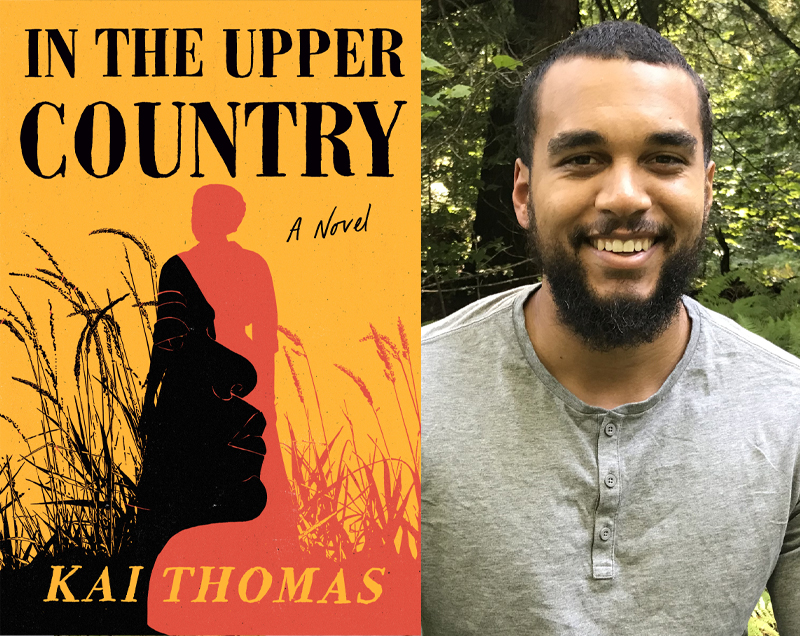
Kai Thomas (Brooke Bridges)
Kai Thomas has always had a peripheral knowledge about the history of Black people in Canada, as he puts it – he was never taught the full and true history in school.
That’s understandable, given that the history of Black people – and Indigenous people – in this country remains largely untold: inaccurately condensed in most classroom discussions, it has only recently started to emerge from the shadows.
Over a recent lively chat, Thomas talked about how these considerations informed his debut novel, In the Upper Country (Penguin, out now), which follows Lensinda Martin as she finds a home among a community of formerly enslaved refugees living in southwestern Ontario during the mid-1800s.
In our conversation about our respective research on the history of Black people in Canada, a mention of formerly enslaved Black people who migrated to Nova Scotia, where I am from, led us to share our lineages, and we quickly discovered we may have descendants in common.
You unearthed parts of the Black experience that haven’t been told enough. What about that history sparked your idea to write this book?
I always had the sense that there must be more to this history than the narrative of white abolitionists giving safe haven to Black folks – I knew there must be more to the story. I also wanted to further explore the War of 1812, the participation of Black and Indigenous people, and their contributions to that war while they were both facing oppression. That pushed me to dive deeper. Through that process I came across that photo of John “Daddy” Hall. What a story!
Yes, John Hall was a mixed Black and Ojibwe man whose mother had escaped to Upper Canada. After he fought in the War of 1812, he was captured and sold into slavery. But you wrote the book from a female perspective. What made you decide this protagonist would be female?
I think it was less of an active choice and more that Black female stories from the 19th century are so underrepresented. It’s not that I was trying to claim that space, but it was an incentive for me to dive into this character. I came across her name in the census records; she was one of John Hall’s children. But her name only shows up once, leaving a mystery about what happened to her. The name Lensinda grabbed me, and I decided to use it for this female character.
I did a lot of research, read some of the greats, and reviewed past writings and narratives on formerly enslaved women. I was motivated by the challenge to make her voice come out right.
There are many layers to writing about Black or Indigenous experiences. For you, what was the hardest part of the book to write?
As a first-time writer, one thing was just learning how to trust the process. Once I realized the work that goes into creating a story of that length, and the process it entails, I was able to let the writing flow. I had some great mentors who helped with that. The other thing was figuring out conceptually what I wanted this book to do. I had originally set out to write a book about John “Daddy” Hall. But instead of telling a real person’s story, I decided to take in that history and do the world building around it. Instead of real characters, I created a parallel world to what had historically existed, and tried to conceptualize that environment, the people in it, and those experiences.
It’s common for writers to change the way the story ends a few times before settling on the one that feels right. At what point did you say, “Yes, here is where and how I want this story to end?”
My ending changed a few times. I followed the guidance from the mentors and editors who worked with me, and I was encouraged to let it flow and then look back over it later to see where it was and how it felt at the end.
What do you hope readers will take away from this story?
It’s hard to know what to expect in terms of how readers will receive your work. I went in with aspirations that [my] depictions of Black and Indigenous people would centre around the theme of land, and I hoped that land as a vehicle for sovereignty would come through. I also hoped, ironically, that it would inspire readers to put the book down and go outside into nature because that theme was important to me.
What comes next for Kai Thomas?
It may be something of a sequel incorporating the same world and a few of the same characters, but I’m not sure what that looks like yet. I am not a fast writer, but it was such a blessing and an honour to work on this story. My hope is to continue working and write an even better book next.
This interview has been edited and condensed.
 Contact us via email
Contact us via email
